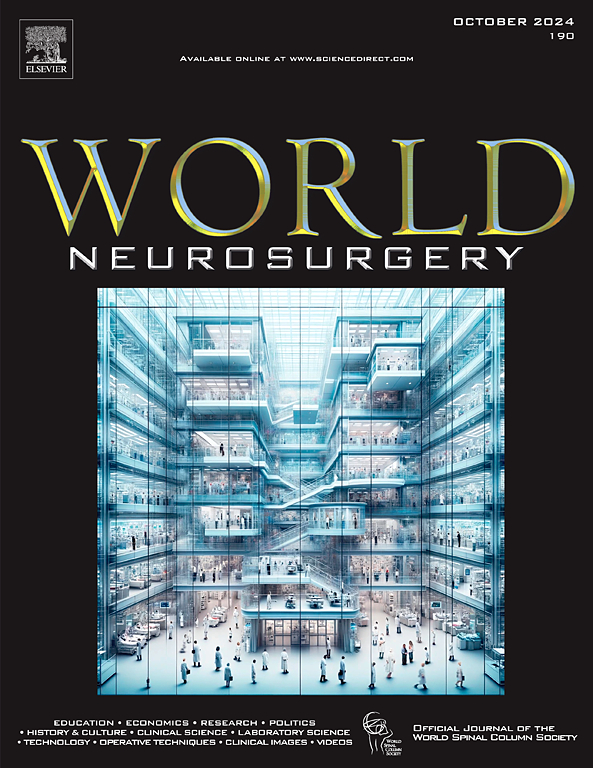Unilateral Biportal Endoscopic Discectomy via the Contralateral Sublaminar Approach for Lumbar Disc Herniation with Very High-Grade Migration: A Technical Note and Case Series
IF 1.9
4区 医学
Q3 CLINICAL NEUROLOGY
引用次数: 0
Abstract
Background
Lumbar disc herniation (LDH) with very high-grade migration is difficult to manage surgically because of its anatomic complexity and the risk of incomplete decompression. The unilateral biportal endoscopic (UBE) contralateral sublaminar approach is a minimally invasive technique that may be an alternative option for managing these cases.
Methods
In this multicenter retrospective study, we analyzed the clinical data of 15 patients with lumbar disc herniation with very high-grade upward or downward migration of ruptured disc fragments removed via the UBE contralateral sublaminar approach between June 2022 and June 2024. Clinical outcomes were assessed using the visual analog scale for back and leg pain, Oswestry Disability Index, and modified MacNab criteria. Radiologic outcomes were evaluated on postoperative magnetic resonance images and serial plain radiographs.
Results
The mean operation time was 45.3 minutes, and the average length of hospital stay was 4.1 days. The visual analog scale scores for back and leg pain improved significantly, and the Oswestry Disability Index was notably lower at the final follow-up. Postoperative magnetic resonance imaging confirmed the complete removal of migrated disc fragments in all patients, with no segmental instability observed during the follow-up. The technique allows for effective decompression with minimal bone removal, thereby preserving adjacent structures.
Conclusions
This study showed the feasibility and potential benefits of the UBE contralateral sublaminar approach for lumbar disc herniation with very high-grade migration of ruptured disc fragments. Although initial outcomes are promising, further comparative studies with more patients are needed to validate its efficacy and safety.
通过对侧椎板下入路进行单侧双侧内窥镜椎间盘切除术治疗腰椎间盘突出症伴有极高等级移位:技术说明和病例系列。
背景:高度移位的腰椎间盘突出症(LDH)由于其解剖复杂性和不完全减压的风险,很难通过手术治疗。单侧双门静脉内窥镜(UBE)对侧板下入路是一种微创技术,可能是治疗这些病例的另一种选择。方法:在这项多中心回顾性研究中,我们分析了2022年6月至2024年6月期间15例LDH患者的临床资料,这些患者通过UBE对侧板下入路切除了高度向上或向下移动的破裂椎间盘碎片。临床结果采用视觉模拟量表(VAS)评估背部和腿部疼痛、Oswestry残疾指数(ODI)和修改的MacNab标准。通过术后磁共振图像和系列x线平片评估放射学结果。结果:平均手术时间45.3 min,平均住院时间4.1 d。在最后的随访中,背部和腿部疼痛的VAS评分明显改善,ODI评分明显降低。术后MRI证实所有患者均完全清除了移位的椎间盘碎片,随访期间未观察到节段不稳定。该技术允许以最小的骨移除进行有效的减压,从而保留邻近的结构。结论:本研究揭示了UBE对侧椎板下入路治疗高度移位的LDH的可行性和潜在益处。虽然初步结果很有希望,但需要更多患者的进一步比较研究来验证其有效性和安全性。
本文章由计算机程序翻译,如有差异,请以英文原文为准。
求助全文
约1分钟内获得全文
求助全文
来源期刊

World neurosurgery
CLINICAL NEUROLOGY-SURGERY
CiteScore
3.90
自引率
15.00%
发文量
1765
审稿时长
47 days
期刊介绍:
World Neurosurgery has an open access mirror journal World Neurosurgery: X, sharing the same aims and scope, editorial team, submission system and rigorous peer review.
The journal''s mission is to:
-To provide a first-class international forum and a 2-way conduit for dialogue that is relevant to neurosurgeons and providers who care for neurosurgery patients. The categories of the exchanged information include clinical and basic science, as well as global information that provide social, political, educational, economic, cultural or societal insights and knowledge that are of significance and relevance to worldwide neurosurgery patient care.
-To act as a primary intellectual catalyst for the stimulation of creativity, the creation of new knowledge, and the enhancement of quality neurosurgical care worldwide.
-To provide a forum for communication that enriches the lives of all neurosurgeons and their colleagues; and, in so doing, enriches the lives of their patients.
Topics to be addressed in World Neurosurgery include: EDUCATION, ECONOMICS, RESEARCH, POLITICS, HISTORY, CULTURE, CLINICAL SCIENCE, LABORATORY SCIENCE, TECHNOLOGY, OPERATIVE TECHNIQUES, CLINICAL IMAGES, VIDEOS
 求助内容:
求助内容: 应助结果提醒方式:
应助结果提醒方式:


